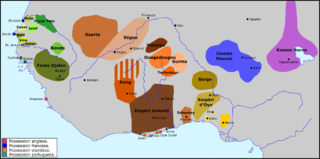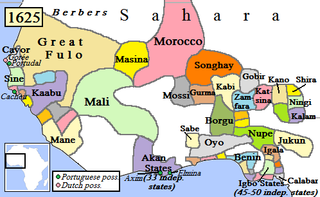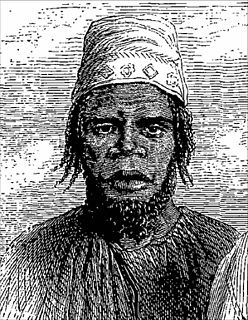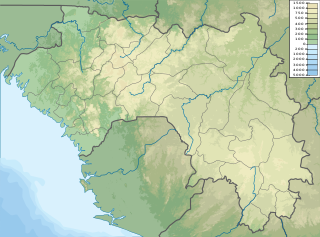Related Research Articles

Fouta Djallon is a highland region in the center of Guinea, roughly corresponding with Middle Guinea, in West Africa.

Timbo is a town and sub-prefecture in the Mamou Prefecture in the Mamou Region of Guinea. It is located in the Fouta Djallon highlands of Guinea, lying north east of Mamou, in a part of the country mostly occupied by the Fula people. It is also known for its vernacular architecture, for the local mountains and for local chimpanzees.

Hadji Oumarûl Foutiyou TALL, , born in Futa Tooro, Senegambia, was a West African political leader, Islamic scholar, Tijani Sufi and Toucouleur military commander who founded the short-lived Toucouleur Empire encompassing much of what is now Guinea, Senegal, and Mali.

Futa Toro, often simply the Futa, is a semidesert region around the middle run of the Senegal River. This region is along the border of Senegal and Mauritania. It is well watered and fertile close to the river, but the interior parts of the region away from the river is porous, dry and infertile. This region is historically significant for the Islamic theocracies, Fulani states, jihad armies and migrants for Fouta Djallon that emerged from here.
Ibrahim Sori was a Fula leader of the Imamate of Futa Jallon in what is now Guinea in West Africa from around 1751 to 1784.

The Kaabu Empire (1537–1867), also written Gabu, Ngabou, and N'Gabu, was an empire in the Senegambia region centered within modern northeastern Guinea-Bissau, larger parts of today's Gambia; extending into Koussanar, Koumpentoum, regions of Southeastern Senegal, and Casamance in Senegal. The Kaabu Empire consisted of several languages, namely: Balanta, Jola-Fonyi, Mandinka, Mandjak, Mankanya, Noon (Serer-Noon), Pulaar, Serer, Soninke, and Wolof. It rose to prominence in the region thanks to its origins as a former imperial military province of the Mali Empire. After the decline of the Mali Empire, Kaabu became an independent Empire. Kansala, the imperial capital of Kaabu Empire, was annexed by Futa Jallon during the 19th century Fula jihads. However, Kaabu's successor states across Senegambia continued to thrive even after the fall of Kansala; this lasted until total incorporation of the remaining Kingdoms into the British Gambia, Portuguese and French spheres of influence during the Scramble for Africa.
The Char Bouba war, or the Mauritanian Thirty Years' War, took place between 1644-74 in the tribal areas of what is today Mauritania and Western Sahara. It was fought between the Sanhadja Berber tribes resident in the area, led by Lamtuna Imam Nasr ad-Din, and the Maqil Arab immigrant tribes, foremost of which was the Beni Hassan.

The Imamate of Futa Toro (1776-1861) was a West African theocratic state of the Fula-speaking people centered on the middle valley of the Senegal River. The region is known as Futa Toro.

The Imamate of Futa Jallon or Jalon was a West African theocratic state based in the Fouta Djallon highlands of modern Guinea. The state was founded around 1727 by a Fulani jihad and became part of French West Africa in 1896.

The Yalunka, or Dialonké, are a Mandé people who were one of the original inhabitants of the Futa Jallon, a mountainous region in Guinea, West Africa. The Yalunka people live primarily in Guinea, particularly in Faranah, while smaller communities are found in Kouroussa. Additional Yalunka are also located in northeastern Sierra Leone, southeastern Senegal, and southwestern Mali.
The Jakhanke also spelled Jahanka, Jahanke, Jahanque, Jahonque, Diakkanke, Diakhanga, Diakhango, Dyakanke, Diakhanké, Diakanké, or Diakhankesare are a Manding-speaking ethnic group in the Senegambia region, often classified as a subgroup of the larger Soninke. The Jakhanke have historically constituted a specialized caste of professional Muslim clerics (ulema) and educators. They are centered on one larger group in Guinea, with smaller populations in the eastern region of The Gambia, Senegal, and in Mali near the Guinean border. Although generally considered a branch of the Soninke, also known as Serahule or Serakhulle, their language is closer to Western Manding languages such as Mandinka.
The Alfaya was the name given to the party from the mid-18th century that favored the clerical successors of the jihad leader Karamoko Alfa in the Imamate of Futa Jallon in what is now Guinea.
The Kingdom of Jolof, also known as Wolof and Wollof, was a West African rump state located in what is today the nation of Senegal. For nearly two hundred years, the Wolof rulers of the Jolof Empire collected tribute from vassal kings states who voluntarily agreed to the confederacy. At the Battle of Danki, the Buurba Jolof was defeated by the lord of Kayor resulting in the rapid disintegration of the empire. Jolof survived as a meager state, unable to prosper from the Atlantic trade between its former vassal territories and the Portuguese.
The Battle of Kansala or Final Battle or Siege of Kansala was a military engagement between forces of the Kaabu Empire and the Imamate of Futa Jallon. The battle ended Mandinka hegemony over Africa’s Atlantic coast begun by the Mali Empire.

Fugumba was the religious center of the Imamate of Futa Jallon. It was about 30 miles (48 km) to the northwest of the secular capital, Timbo, and lay in the valley of the Téné River.

Karamokho Alfa was a Fula religious leader who led a jihad that created the Imamate of Futa Jallon in what is now Guinea. This was one of the first of the Fulbe jihads that established Muslim states in West Africa.
The Torodbe were Muslim clerics who were active in the Western Sudan region of Africa from the 17th century and included people whose origin was Fula, Wolof, Mandé, Hausa and Berber. Their teachings in part inspired the series of jihads that the Fulbe launched at that time.
Maka Jiba was the ruler of Bundu in West Africa between around 1720 and 1764.

The Battle of Porédaka was a minor engagement in which French colonial troops decisively defeated the last forces of the Imamate of Futa Jallon, after which Fouta Djallon was annexed into the Senegambia Confederation.
Bokar Biro Barry was the last independent ruler of the Imamate of Futa Jallon in what is now Guinea. He died in the Battle of Porédaka, when his forces were destroyed by French artillery.
References
Citations
- 1 2 Ogot 1992, p. 292.
- 1 2 Rashedi 2009, p. 38.
- ↑ Diallo 2010, p. 39.
- ↑ Adamu 1988, p. 244.
- ↑ Baumgardt & Derive 2005, p. 154.
- ↑ Thornton 1999, p. 43.
- ↑ Gomez 2002, p. 72.
- ↑ Reichardt 1876, p. 320.
Sources
- Adamu, Mahdi (1988-11-01). Pastoralists of the West African Savanna. Manchester University Press. ISBN 978-0-7190-2248-7 . Retrieved 2013-02-11.
- Baumgardt, Ursula; Derive, Jean (2005). Paroles nomades: écrits d'ethnolinguistique africaine : en hommage à Christiane Seydou. KARTHALA Editions. ISBN 978-2-84586-708-6 . Retrieved 2013-02-11.
- Diallo, Abdoul Goudoussi (July 2010). Labé ville-champignon de Guinée. Harmattan. p. 39. ISBN 978-2-296-25940-9 . Retrieved 2013-02-11.
- Gomez, Michael A. (2002-07-04). Pragmatism in the Age of Jihad: The Precolonial State of Bundu. Cambridge University Press. ISBN 978-0-521-52847-4 . Retrieved 2013-02-11.
- Ogot, Bethwell Allan (1992). Africa from the Sixteenth to the Eighteenth Century. UNESCO. p. 292. ISBN 978-92-3-101711-7 . Retrieved 2013-02-11.
- Rashedi, Khorram (January 2009). Histoire du Fouta-Djallon. Harmattan. p. 38. ISBN 978-2-296-21852-9 . Retrieved 2013-02-11.
- Reichardt, Charles Augustus Ludwig (1876). Grammar of the Fulde language: With an appendix of some original traditions and portions of Scripture translated into Fulde: together with eight chapters of the book of Genesis. Church missionary house. Retrieved 2013-02-11.
- Thornton, John Kelly (1999). Warfare in Atlantic Africa, 1500-1800. Psychology Press. p. 43. ISBN 978-1-85728-393-8 . Retrieved 2013-02-11.